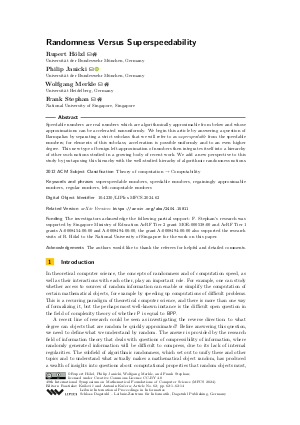Randomness Versus Superspeedability
Authors
Rupert Hölzl,
Philip Janicki  ,
Wolfgang Merkle,
Frank Stephan
,
Wolfgang Merkle,
Frank Stephan
-
Part of:
Volume:
49th International Symposium on Mathematical Foundations of Computer Science (MFCS 2024)
Part of: Series: Leibniz International Proceedings in Informatics (LIPIcs)
Part of: Conference: Mathematical Foundations of Computer Science (MFCS) - License:
 Creative Commons Attribution 4.0 International license
Creative Commons Attribution 4.0 International license
- Publication Date: 2024-08-23
File

PDF
LIPIcs.MFCS.2024.62.pdf
- Filesize: 0.73 MB
- 14 pages
Document Identifiers
Related Versions
- arXiv Version https://arxiv.org/abs/2404.15811
Subject Classification
ACM Subject Classification
- Theory of computation → Computability
Keywords
- superspeedable numbers
- speedable numbers
- regainingly approximable numbers
- regular numbers
- left-computable numbers
Metrics
- Access Statistics
-
Total Accesses (updated on a weekly basis)
0PDF Downloads0Metadata Views
Abstract
Speedable numbers are real numbers which are algorithmically approximable from below and whose approximations can be accelerated nonuniformly. We begin this article by answering a question of Barmpalias by separating a strict subclass that we will refer to as superspeedable from the speedable numbers; for elements of this subclass, acceleration is possible uniformly and to an even higher degree. This new type of benign left-approximation of numbers then integrates itself into a hierarchy of other such notions studied in a growing body of recent work. We add a new perspective to this study by juxtaposing this hierachy with the well-studied hierachy of algorithmic randomness notions.
Cite As Get BibTex
Rupert Hölzl, Philip Janicki, Wolfgang Merkle, and Frank Stephan. Randomness Versus Superspeedability. In 49th International Symposium on Mathematical Foundations of Computer Science (MFCS 2024). Leibniz International Proceedings in Informatics (LIPIcs), Volume 306, pp. 62:1-62:14, Schloss Dagstuhl – Leibniz-Zentrum für Informatik (2024)
https://doi.org/10.4230/LIPIcs.MFCS.2024.62
BibTex
@InProceedings{holzl_et_al:LIPIcs.MFCS.2024.62,
author = {H\"{o}lzl, Rupert and Janicki, Philip and Merkle, Wolfgang and Stephan, Frank},
title = {{Randomness Versus Superspeedability}},
booktitle = {49th International Symposium on Mathematical Foundations of Computer Science (MFCS 2024)},
pages = {62:1--62:14},
series = {Leibniz International Proceedings in Informatics (LIPIcs)},
ISBN = {978-3-95977-335-5},
ISSN = {1868-8969},
year = {2024},
volume = {306},
editor = {Kr\'{a}lovi\v{c}, Rastislav and Ku\v{c}era, Anton{\'\i}n},
publisher = {Schloss Dagstuhl -- Leibniz-Zentrum f{\"u}r Informatik},
address = {Dagstuhl, Germany},
URL = {https://drops.dagstuhl.de/entities/document/10.4230/LIPIcs.MFCS.2024.62},
URN = {urn:nbn:de:0030-drops-206187},
doi = {10.4230/LIPIcs.MFCS.2024.62},
annote = {Keywords: superspeedable numbers, speedable numbers, regainingly approximable numbers, regular numbers, left-computable numbers}
}
Author Details
Funding
The investigators acknowledge the following partial support: F. Stephan’s research was supported by Singapore Ministry of Education AcRF Tier 2 grant MOE-000538-00 and AcRF Tier 1 grants A-0008454-00-00 and A-0008494-00-00, the grant A-0008494-00-00 also supported the research visits of R. Hölzl to the National University of Singapore for the work on this paper.
Acknowledgements
The authors would like to thank the referees for helpful and detailed comments.
References
-
George Barmpalias. Personal communication, 2023.

- Vasco Brattka, Guido Gherardi, and Arno Pauly. Weihrauch complexity in computable analysis. In Vasco Brattka and Peter Hertling, editors, Handbook of Computability and Complexity in Analysis, pages 367-417. Springer, 2021. URL: https://doi.org/10.1007/978-3-030-59234-9_11.
- Cristian S. Calude. Information and Randomness: An Algorithmic Perspective. Springer, 2nd edition, 2002. URL: https://doi.org/10.1007/978-3-662-04978-5.
- Rod Downey and Denis Hirschfeldt. Algorithmic Randomness and Complexity. Springer, 2010. URL: https://doi.org/10.1007/978-0-387-68441-3.
- Rodney G. Downey and Evan J. Griffiths. Schnorr randomness. Journal of Symbolic Logic, 69(2):533-554, 2004. URL: https://doi.org/10.2178/jsl/1082418542.
- Johanna N. Y. Franklin and Frank Stephan. Schnorr trivial sets and truth-table reducibility. Journal of Symbolic Logic, 75(2):501-521, 2010. URL: https://doi.org/10.2178/jsl/1268917492.
- Peter Hertling, Rupert Hölzl, and Philip Janicki. Regainingly approximable numbers and sets. Journal of Symbolic Logic, 2024. Appeared online. URL: https://doi.org/10.1017/jsl.2024.5.
- Rupert Hölzl and Philip Janicki. Benign approximations and non-speedability, 2023. Preprint. URL: https://doi.org/10.48550/arXiv.2303.11986.
- Mathieu Hoyrup. Genericity of weakly computable objects. Theory of Computing Systems, 60(3):396-420, 2017. URL: https://doi.org/10.1007/s00224-016-9737-6.
- Ming Li and Paul Vitányi. An Introduction to Kolmogorov Complexity and Its Applications. Springer, 3rd edition, 2008. URL: https://doi.org/10.1007/978-0-387-49820-1.
- Donald A. Martin. A theorem on hyperhypersimple sets. Journal of Symbolic Logic, 28(4):273-278, 1963. URL: https://doi.org/10.2307/2271305.
- Per Martin-Löf. The definition of random sequences. Information and Control, 9(6):602-619, 1966. URL: https://doi.org/10.1016/S0019-9958(66)80018-9.
- Wolfgang Merkle and Ivan Titov. Speedable left-c.e. numbers. In Henning Fernau, editor, Proceedings of the 15th International Computer Science Symposium in Russia, Lecture Notes in Computer Science 12159, pages 303-313. Springer, 2020. URL: https://doi.org/10.1007/978-3-030-50026-9_22.
- André Nies. Computability and Randomness. Oxford University Press, 2009. URL: https://doi.org/10.1093/acprof:oso/9780199230761.001.0001.
-
Piergiorgio Odifreddi. Classical Recursion Theory: The Theory of Functions and Sets of Natural Numbers. Elsevier, 1992.

- Claus Peter Schnorr. Zufälligkeit und Wahrscheinlichkeit. Springer, 1971. URL: https://doi.org/10.1007/BFb0112458.
- Robert I. Soare. Cohesive sets and recursively enumerable Dedekind cuts. Pacific Journal of Mathematics, 31:215-231, 1969. URL: https://doi.org/10.2140/pjm.1969.31.215.
- Guohua Wu. Regular reals. Mathematical Logic Quarterly, 51(2):111-119, 2005. URL: https://doi.org/10.1002/malq.200310129.
